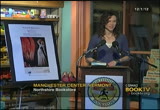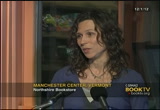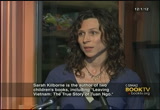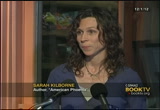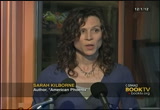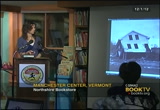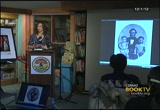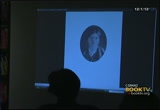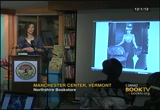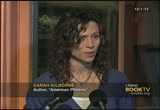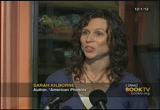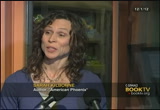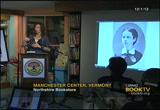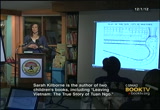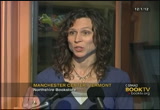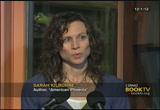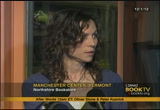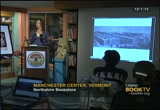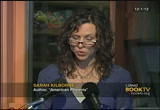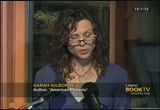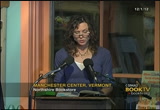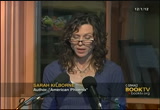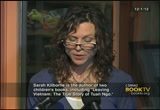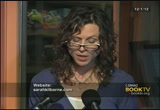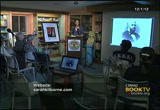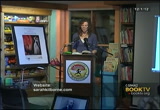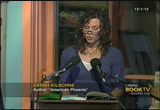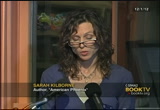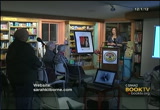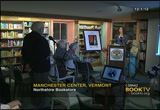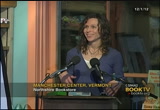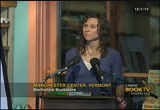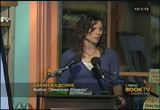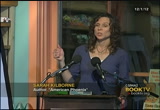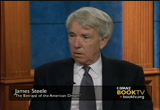tv Book TV CSPAN December 23, 2012 10:00pm-11:00pm EST
10:01 pm
think you. thank you for your support of "american phoenix." thank you for coming out tonight and also c-span and booktv. is an honor. i am thrilled to share with you "american phoenix" the remarkable story of william skinner, a man who turned disaster into destiny" one question every writer gets when people find out if you're writing a book.
10:02 pm
cocktail party or supermarket or on the street, what is your book about? that is a fair question. it is a good one and extremely challenging to answer. you have spent thousands of hours writing thousands of words with a ton of information in your head and the right to one story that includes many others that do have to figure out how to condense the information into a 152nd sound bite of the 10 words or less. i have it down to seven words if you include "american phoenix" is about. people ask if your book was made into a movie house would you give it? >> the titanic meets rocky.
10:03 pm
"american phoenix" is about in essence disaster and a survival. disaster of epic proportions that involve a lot of water, engineering failure, failure of design that killed a lot of people. and survival. triumph of the human spirit the will to overcome extreme adversity to get up when you have been knocked down again and again. my book explores the challenge to rebuild your life after a catastrophe and also the discovery our worst nightmares can turn into greatest opportunities. it is poignant to be in vermont talking about "american phoenix" especially after the devastation caused by hurricane ike read because you can relate to what
10:04 pm
william skinner went through 130 years ago to rebuild their lives. and now with her cane sandy of those in new jersey and staten island can also unfortunately relate to to this challenge. what do you do? whether we come to the story line with that connection we all have disasters. and the unexpected moments when suddenly things are not the same. we are in a new paradigm. how do we survive? this moment of crisis will test us. instincts, loyalties, faith in ourselves, creativity, he motions and certainly our
10:05 pm
courage. may 16, 1874 a reservoir dam gave way in western massachusetts to a nation in and tidal wave that was between 20 and 40 feet high and 300 feet wide and came down a 14-mile valley swept through williamsburg williamsburg, skinnerville, florence and new hampton. to give a sense of the power to appreciate the time it took to pass through portions of the valley. in the lower portion the land was turned into a plane and it took an hour and a half to fled northampton to flood into the connecticut river. in the of the region's the 600 million gallons of water
10:06 pm
went through a williamsburg williamsburg, skinnerville and hated bill 15 minutes each. the worst industrial disaster at the time. over $1 million of property damage was sustained almost a hundred people left homeless and 139 were killed my input book is about the only village not be built skinnerville and william skinner. what set his story apart is the success and he achieved after the disaster. skinnerville had the worst destruction, it was obliterated from the face of the earth and a one. left, his house was the only one left standing and he lost more financially than any other individual he lost the equivalent of
10:07 pm
$35 million. he was ruined but because he made choices that nobody else would make he could come back. the other manufacturers in a the valley could not rebuild successfully. they had gone out of business, a bankruptcy, and sold businesses and left town. historian said three years later men of abundance could withstand the shock of disaster was more nefarious than expected. but skinner by himself went on to rebuild his company and as sole proprietor turned it into one of the most successful innovations history. his silk mill was considered the largest in the country when he died in 1908
10:08 pm
deschutes 1902 and a multimillionaire. that success would never have been possible had he not lost everything and how to figure out how to survive making choices he would not be forced to make. he annamese survive disaster but turned it into the greatest success. this is a map of the town of williamsburg 1873. this is the reservoir. the kidney shape williamsburg, skinnerville, and haydenville. this is the image of saddam after it had given way.
10:09 pm
and earth in dam with a core wall of masonry. this is all that was left. this is a graphic depiction of water going past skinner's house during the flood. they said the house survived a because it was routed to the ground and made of board, not precut was so large it acted like a with the waters surging around the front to the back shattering windows, flooding the interior of the first floor. the back parlor floor collapsed and all contents felt in the cellar below. potatoes and pianos and pictures and pork, books and bacon were mixed in the flooded seller. he move this house with him
10:10 pm
when he relocated after the flood it was taken apart piece by piece and transported on 25 railroad cars where he rebuilt. is now a museum on national register of historic places and you can visit. this is an image what was left of skinnerville. it is hard to imagine what it was like before. a thriving factory village, houses, trees, a stone walls, farmland and the silk mill. right here is the foundation, all that was left of the mill. far to the left extended. here was his house. this is an image on the
10:11 pm
cover of my book. there was no damage so we had to choose one that represented the disaster. this is all that was left of the neighboring factory 600 feet long, the length of two football fields. more devastation from the village of skinnerville. here is the house from the bartlett family who lived in skinnerville many children worked for skinner. a superintendent henry worked for him at the time of the flood. department family lived in this house through the summer in exactly this condition because they had nowhere else to go. when skinner died in 1902 his son took over the
10:12 pm
company. they were a brilliant team. joe designed and he took over production and ran the labs inventing fabrics that involved sillcock. will handle the marketing and sales. they carried on their father's innovation and pioneering in the industry skinner was the first to branch out to the consumer advertising this is from good housekeeping here is an ad from 1931 with joan crawford. skinner's silks and satins were favorites of hollywood costume designers. this is wilson doing. he wrote hollywood. designers love to them because they're natalie beautiful with extraordinary
10:13 pm
draping qualities but durable. they could bush stand where and tear of a costume on said. a the man at the top was the head costume designer of mgm, one of the most famous of the time and he actually helped to advertise the products. i shall also had the whole advertising campaign involved joan crawford, bette davis the idea was if you dress in the scanner silks and satins, you too, can be a star. here is an act featuring bridal section here is another one from the mid 1940's from "glamour" magazine. when the soldiers returned
10:14 pm
they got married in droves on many were getting married in the bridal sutton. it took the company to a whole new level of success. >> the company survived through 1961. 113 years after skinner founded it fixer their impact the company had throughout its existence the reader's digest included william skinner on a list of the most influential english men to land on american soil. and at that time they had the largest readership in the country, second to the bible. when asked what is your book about? then they ask how did you find your story?
10:15 pm
it had to do with my family. william skinner was my great great grandfather. here is an image of him around the age of 30. he just lost his first wife nancy. he is a woodworker in this picture with his two young daughters and opened his silk mill in the area known as skinnerville. i find that photograph haunting. the intensity in his eyes just burns. he is so driven and ambitious. yet to tenderly clutching his daughter's. this is a photograph of his first wife nancy warner and died shortly after the death of the second daughter. then he married again to
10:16 pm
elizabeth allen i. and named after her. one would think with william skinner been my great great grandfather i am named after his second wife who was the white for the rest of his life but my grandfather was the last president of the company that i would have grown up hearing about william skinner and his story. i did not. that story was lost in the legacy of the company. it came so big it overshadowed the founder. there were only two things that i knew about william skinner. one. i just barely knew he was english i only knew of one expression that was very
10:17 pm
austere. remember, if you are william scanners and descendants. do good in the world. that is all i knew of him but ultimately being named lead me to her father's story bell was the second and this daughter i was fascinated with her she was a famous philanthropist in france after row of war one and she legally adopted an entire village from the french government and then north east of france. legal binding document and rebuilt it after the war. the french considered hopeless. she came and took it on and did exist to this day because of her.
10:18 pm
she was larger than life. she had nicknames for everyone, including the president, she war fabulous hats, and not pretty but very handsome with a commanding presence and worked with the french government. and i wondered as i looked into her life, what would compel this woman in her 50s leading a comfortable life to become so passionately involved to resurrect a devastated village? rewind when eight years old skinnerville was destroyed in the flood and never rebuilt. i began to research the flood as the inroad to the belle skinner story but as i began to learn more about the flood summit william skinner and tell that point*
10:19 pm
who was on known became alive. he was such a central figure that the papers followed his every move. suddenly i am following his every move. i knew how the story endured-- ended. he was a success but with the extraordinary loss to come back from that i became incredibly impressed with what he could achieve. the story is resiliency. never give up. obstacles or opportunities. for a problem there is a creative solution. you have to find it. do not believe in not. make rome look. work hard for what you want. do not believe in failure. believe in yourself. these are things that skinner believed. he learned resiliency as a
10:20 pm
kid. born in london 1824. into a slum of such poverty born into a community of silk workers making silk for generations. weaving and dyeing but they were so pour and malnourished they recalled the stunted and puny race. advocates said not that if you would start this on many were on the verge of starvation. not that they suffer but so few escaped. he did. he came to the country at the age of 20. he had nothing with him. but he had one thing nobody had in america. it was extremely quality which was the knowledge of how to die so.
10:21 pm
there was no silk industry in this country at that time. they did not know how to make machinery, a diet, have the tools, everything was trial and error to create the silk industry. it was our industrial revolution how we get in on the trade? there's so much money to be made in silk. it is hard to appreciate what it meant to the culture back then. before the age of synthetic fabrics and designers fabric was fashion and silk was the ultimate in style to represent prestige, prosperity, a success. america wanted its own silk industry. skinner would say nobody comes over with and ambition not to wear the silk dress. everybody wanted so. he came to the country with
10:22 pm
knowledge and was a pioneer in the industry. established its. a founding member of the american soccer association and he took that one in this bill into opportunity after opportunity. to the point* he had his own and silk mill. it was a prosperous an entire village stage village groups around it called skinnerville. the poor kid from east london literally put his name on the map. to write the book i had to recreate skinnerville because it disappeared after the flood. here is a map of skinnerville from 1873. i need to go back.
10:23 pm
i dunno how to do that. how do you do that? a lot of research, archives research, archives, eddied, probate documents, of vital statistics, a tax records records, census, i should own stock with ancestry.com i spend so much money on the web site. i put together with this committee consisted of. , the children did they have? to lift? who was pregnant at the time, given birth two days before, there is only so far you can go on your own but something's come when you are forever grateful. one day i received a phone call from skinner's home that is now a museum and they told me a collection of letters was just donated by
10:24 pm
a descendant of sisters who had worked for skinner and his mill and its skinnerville they opened up what it was like to live in the village. when it was like to work for skinner, as an employer, a mill girl and the middle of the 19th century. living far away from home but at this time millwork was very respectable for a young woman. if you had ambitions, you could make a lot of money, you would not lose any respectability, it did not affect your character, a sense of independence, and make your own money. bill littlefield sisters from upstate new york. the first sister was 20
10:25 pm
years old who came in 1866 and was visiting cousins who lived in chesterfield and they told her skinner was looking for new workers. she applied, got the job and was an expert schooler says she worked in the finishing department. she would take the silk thread from the dye house and wind it on the school to go to market. it required tremendous skill because you could not damage the silk whatsoever. it would be sold. she was fantastic. another sister followed named francis. one sister would work in the milken if she had a good experience then she would send word. , join me. said you had a number of siblings working together.
10:26 pm
a family environment. the third sister was alan. she lasted both of resistors and is working for skinner at the time of the flood and is a stronger character of the book and after words help to salvage his silk and she moved to holyoke and ultimately married his bookkeeper. after the flood the valley could potentially be somebody else's gain. after the disaster the valley was a popular spot for investors and capitalist.
10:27 pm
investors came as far away from omaha nebraska to give them incentives to relocate to other areas. one of the most vocal voices was from holyoke massachusetts. they were ingenious lee is specifically designed for industry. it was hoped to be greater than the urban centers. holyoke was the greatest potential power of new england. the dam the connecticut river on the right is at the crest of a 60-foot fall capable of generating 30,000-horsepower that was the power of 300 mills. the cotton lords that created holyoake devised a
10:28 pm
three tiered canal system. it does not show on this map the connecticut river could be used over three times. holyoke made offers to the manufacturers in the valley. skinner is the only one who expected the offer and moved he is the only one who survives. skinner needed money and water power. skinnerville he would have to rely on steam to rebuild because the reservoir would not be rebuilt. going forward with the dry season when the river ran
10:29 pm
though, skinner would have to supplement with steam which was very expensive. for his amount of debt it was too expensive. he would have to rebuild the entire infrastructure of the village. the houses for the workers, everything. he needed a lot of water power. to die silky need a lot of water and he needed the power to power machinery. holyoke could offer consistent water power 365 days per year without a reservoir over his head. holyoke also offered many. better than that, they said we would give the property on the canal worth $6,000 for free over five years.
10:30 pm
no rent. we will build a new mill no penny down just pay the interest payment at the first of the year for five years at the end of the five years you can buy pate back the land in the mill at the original cost. he can literally get going without putting anything down. the city said you give you 1 acre of land for free to build a new home. of course, he relocated the property he did not have to pay for. he would of had to have the burden of every expense you would enter. this is the first mill skinner had it went up six
10:31 pm
months to the day of the flood. in holyoke. and ultimately skinners mill turned into that. the largest silk mill under one roof in the world. 1874, a success of this scope was impossible to imagine. and what what it would take to achieve that. 1874, skinner thought he was the head of his game. 49 years old, a wife, seven children, a village of 200 growing up around his mill, the head of the american soap trade, bullish
10:32 pm
on the pgm believed silk would become big business. it did. 87 before he thought how can i expand my business today? he would say what is the biggest room in the world? the room for improvement with 1874 he was looking to improve the business bullish on the future looking ahead. how could he become even better? with that i will read an excerpt from the book that i will take questions. i apologize in advance i cannot read and look up because i now need glasses. they will slip on my nose. i will have to keep my nose in my book.
10:33 pm
>> the evening of may 13, 1874, the tall robust english man walked through the door of the restaurant in new york city. neatly dressed with sets and tram, a bow tie and a waistcoat and impressively over his girth. he was greeted by a host of familiar faces and hands reaching out to shake his. an american custom that he was accustomed. in that environment his accent reing out like a clarion call women were hard-pressed to find a well trained staffer who did not raise an eyebrow. everything about william skinner stood out.
10:34 pm
even his head. he did not like cats he would not wear them despite the courtesy on the street. the old canal mansion skinner joint men who were filing upstairs to a private banquet room. they came from many places that had one thing in common, silk. leading manufacturer of american silk industry, congressman, local politicians, even a japanese dignitary. he was stepping on the english manner that of 49 he was one of the oldest. he was specifically asked to give a toast to reflect on the past to honor the pioneers for those who turned silk into the enviable position. he did not want to be part of the lineup but wanted to sit back and relax the one
10:35 pm
colleague successfully talked him into it. port and uneducated he had social inferiority. with a formidable knowledge of the industry or the astonishing success. he had a flair for the dramatic and he possessed a natural ability to hold an audience's attention. this the you would keep things short made him a popular speaker. as he climbed the carpeted stairs chatting with friends and colleagues, part of his speech was already written out to and in his pocket. anyone who read the paper or knew anything but to lunch or dying at the restaurant were for those who aspired to notoriety.
10:36 pm
the most manchuria's restaurant that ever existed suggested irrefutable success, socially and financially. it conveyed to the press in the public that this group of ambitious men had arrived. tireless, determined and billion endeavour's from the established the silk industry in the united states. and long-lasting national organization devoted to their cause. tonight men were celebrating the second anniversary of the silk association of america and the exhilarating truth the american silk industry is a power in the land. the private dining room had flags representing all the great silk producing nations of the world the empire of japan and u.s. flag joined in solidarity. banners from every state in
10:37 pm
the union were hanging reminding each manufacturer that he was part of a union, industry of thousands that he was a vital member. at the center of all was a sea of balloons that was each tied with silk thread to the stem of a champagne glass. later with the toast under way the balloon's served another purpose the feeling would appear to rise up to raise class's in unison to elevate the celebration for their. it was also printed on american silk. like miniature silk scarves
10:38 pm
that under the glow of the chandeliers. devised by new york's most famous chef who was quite unintelligible. the banks had more familiar english. then there was skinner's speech, cherishing the recollection of the past to emulate their example. with a great deal of reminiscing to take place but they would help to put a flourishing cap on that topic. they're not only benefactors of the past but the future and they are also making history.
10:39 pm
>> two days later skinners on a train headed up the connecticut shoreline north to massachusetts. he visited this cd -- city near the every month and was on the last train of the day putting him on target to reach skinnerville just after 9:00 p.m.. there was no dinner train unlike two nights before it would most likely be packed and negative brown bag for a traveling businessman. past the white church spires they would fall toward the west and the temperature began to drop.
10:40 pm
the towns of western massachusetts were known for the long winter in this was not an exception. there was still snow on the ground in patches. and was miles from any weather. the tracks were clear and was wrapped of a winding down the most rewarding business trip he ever had. he was hailed as a pioneer in the field he was so successful he was highlighted in the papers and the industry considered to be the most exciting in america. the store was filled with activity just hiring a new sales and named fred warner. and getting ready to expand it again.
10:41 pm
especially ribbons that were the rage. he already had the requisite to and hands and even hired a local architect to design a few within eight tenements to house the employees he planned on hiring. but something else was on his mind. friday, that may 15, 1874. the 18th wedding anniversary and hid in and protected there was of build the line to box from tiffany for his precious wife lizzy. skinner loved to give things and on a similar occasion when he could not be home on his anniversary he returned with a diamond scarfskin beautifully wrapped for the
10:42 pm
women he called my darling. and was much better educated and having herself worked as a teacher for many years. there was nothing this woman could not do too late linoleum or explain mathematics. following the birth of their fourth child she would handle the affairs at the milk while skinner was in england and ran the boarding house. and was intimately involved in her husband's business but she was the wife of a rich manufacturer. there is no economic reason for her to absorber these responsibilities. she took them on. but lizzy was a partner for the first wife died young.
10:43 pm
but she had raised the children as her own and given birth to age more and of the 10 children seveners still living and all were thriving. and with smart educated young women. but studying french with nine other than george to would be the prime minister of france. going one step further and nina went to college was up in poughkeepsie new york. the oldest, will, 17 was about to close out high-school at the prestigious seminary in east hampton and massachusetts. graduation was a few weeks away if he could make it without being expelled. he is charming, handsome and
10:44 pm
complete ambivalent about his education. even so scanner hoped he would go to yale. also libby, 14 at boarding school in new haven connecticut putter's school year just ended and she was home again. joe 11, of belle glade was eager for summer break. joe bought a baseball bat and a very young guests catherine only six on sold recently made her first appearance in public with the world delighting in her as she in it. skinner's train pulled into new haven before 6:00 departing passengers grabbed their bags for a throng of do face is come aboard looking for an available seat if they wanted to read with the light of day.
10:45 pm
then the train pulled into north hampton were skinner made his way to the exit and down the steps of the platform. he transferred to a one car special that chicken the last lake of his journey up the branch railroad. the train passed the villages of haydenville from the gas lights that were on the street then skinnerville came into view. their lights on across the river and in houses down by the road. the mill was a large shadow nearly station nearly indistinguishable. it was pitch black with a new moon but his own home the three story mansion setback with tall french windows stretching from front to back was
10:46 pm
identifiable with several rooms lit up in preparation for his arrival. through the air came the sound of the bell tolling at 9:00. he did not know who would still be a. the baby went to bet at 730 and the younger children at a 30. but there was a possibility that bill and joe could keep their eyes open to welcome all fodder and libby just returned from school she could have callers brady playing checkers with mother while nelly in knitted by the fire. as the train slowed the approach one employee, john awaited him. the depot was a quarter mile up on a dark on the road and into the cold night air
10:47 pm
already on a short jog home. the anniversary behind him and the new year in the light of his marriage and his work was about to begin. 49 years old and the fabric of his existence had never been stronger. as he walked up the steps in the middle of skinnerville with the river flowing behind him, the mill across the way, the houses all-around any reunion with wife and children seconds ahead, there is not one clue or any sign that the very next morning nearly everything in his world would be swept away. think you. [applause]
10:48 pm
i would ask you if you would step up to the microphone. what was the source of the of raw material for his silk works? >> it was raw silk from china. it was rob. it came from china and ultimately he would trade and imports from japan. raw silk is like he imported and converted into thread and that was turned into fabric. >> what does it look like? >> here is a silkworm cocoon. the moth is still inside. the manufacturing of silk is very complicated and the
10:49 pm
extraordinary process. this one a cocoon is wound was one strand of silk half a mile long but it is so fine it is barely perceptible and nowhere near enough shape to be used as the red. in a nutshell, fink of a pyramid and silk cocoons at the bottom the filaments are wound together into a layer and then another layer until you have one thread made of various silk filaments. it is silk that has been unwound from the cocoon and joined together part way up the pyramid that arrives in
10:50 pm
states in bundles they were called books. >> did they ship textile as well? >> yes. he began to manufacture silk threadfin in holyoke he would weave the thread into fabrics that enabled him to succeed because when he rebuilt the mill he did not just rebuild to house the operation then but he built the mill of his dream so there was room to expand his business into leaving. >> did william skinner had any relationship with cml
10:51 pm
page samuel, whose nose stretched from northampton to holyoake was the largest employer from the mid-19th century. he helped to establish holyoke, he saved and hearst college from extinction and a supporter of massachusetts aggie many decades later now known as university of massachusetts. >> that is an interesting question. i am thrilled you know, so much about the valley. skinner did not work with samuel wilson. he was a capitalist and help to support many industries. he was a partner with the hated brass company that is on the cover of my book but
10:52 pm
he did not do business with william skinner. >> with skinnerville what survives? any serious or imager archeological search for evidence of the mill? what can you find at the site today? >> that is a question station -- great question for you find a stretch of highway, a few houses. some were racks at the time refashioned into homes. of very trying to asia -- train quote river no archaeological dig that i know wealth.
10:53 pm
if you want to find the area of his house there is a utility, like a substation and the locals say that is where his house was. locals still refer to the theory at as skinnerville but it is not on the map. you used to be able to go to the river to find a bricks and the river bank that were washed away. over 130 years most of the debris has been taken by scavengers. that is know i've learned about the flood. i found a silver spoon and pieces of pottery and china. >> second, holyoake the mill at the greatest extent to any of those buildings standing? a great question.
10:54 pm
>> skinner's know is not standing it was set on fire by arsine in their early eighties when it had a rash of arson. someone told me when the bill turned it was so intense the water in the canal boiled it is now a park. there is no remaining bill buildings of skinner's mill. the only building that remains is the house that he salvaged. in the museum you can go and see illustrations, advertisement s, photographs and a paper record of the company and what it involved but no physical record anymore but there is some the generation of holyoke figuring out how
10:55 pm
to use the abandoned mill building to make them a destination. >> on the day of the flood was it like for the skinner family? what did they do? >> you will find out if you read that book. it was a rainy day. the first sound of alarm was a dairy farmer to came shouting the reservoir has given an play. run to the hills. it or fend ran to the top and began to ring of bill belle. this bitter family was at breakfast his bill was up
10:56 pm
running he did not have to be there. actually he had slept in. from the trip before he had overslept. his first thought was there was a fire why else would the bell rang? he looked north and saw a massive blackness and heard a shout of the dairy farmer. and skinner ran down the street and operatives were already beginning to come out of the mill and he started to shout run to the hills. once the last one to ring gauge the the know which was the orphan he ran to the
10:57 pm
family grab the baby. run. run for the hill they ran for the embankment and escapes within seconds when he turned around the water had swept it was like standing on the deck of a ship in the middle of a violent storm. [applause] thank you. >> you don't always find embracing investigative reporting but it is not just economics but a discomfort that often causes in the newsroom because it is troublesome. if you ruffle the feathers
10:58 pm
128 Views
IN COLLECTIONS
CSPAN2 Television Archive
Television Archive  Television Archive News Search Service
Television Archive News Search Service 
Uploaded by TV Archive on

 Live Music Archive
Live Music Archive Librivox Free Audio
Librivox Free Audio Metropolitan Museum
Metropolitan Museum Cleveland Museum of Art
Cleveland Museum of Art Internet Arcade
Internet Arcade Console Living Room
Console Living Room Books to Borrow
Books to Borrow Open Library
Open Library TV News
TV News Understanding 9/11
Understanding 9/11

